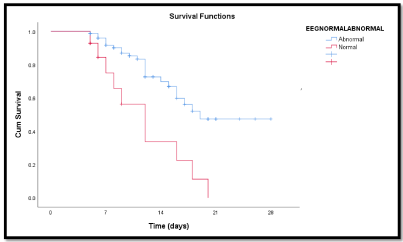-
Home
-
About JCTR
-
Gold Open Access
-
Issues
-
Editorial board
-
Author guidelines
-
Publication fees
-
Online first
-
Special issues
-
News
-
Publication ethics
-
Partners
-
Submit your manuscript
-
Submit your review report
-
Editorial Office
-

This work is licensed under a Creative Commons Attribution-NonCommercial 4.0 International License. ISSN print: 2382-6533 ISSN online: 2424-810X
Volume 7 issue 4
EEG abnormality as a prognostic factor in cirrhotic patients with grade III-IV hepatic encephalopathy requiring mechanical ventilation: a retrospective analysis
Lalita Gouri Mitra, Geeta Rajput, Vandana Saluja*, Guresh Kumar
Mitra et al. J Clin Transl Res 2021; 7(4):3
Published online: July 16, 2021
Abstract
Background & aim: Hepatic encephalopathy is a serious complication that entails liver cirrhosis with a high mortality rate. The Child- Turcotte-Pugh class (CTP class) and model for end-stage liver disease (MELD) score are two important prognostic indicators for cirrhosis, while sequential organ failure assessment (SOFA) is a dynamic score for the assessment of critically ill patients. Patients with liver disease with advanced CTP class and higher MELD scores have poor prognosis. The aim of this study was to evaluate the role of electroencephalography (EEG) in cirrhotic patients requiring ventilator support for hepatic encephalopathy grade III-IV.
Methods: A retrospective study was conducted on patients admitted to the liver intensive care unit (ICU) of a tertiary teaching institute. EEG records of 92 patients with grade III-IV hepatic encephalopathy who were admitted between April 2015 and May 2017 to the liver ICU were analysed. The correlation between EEG findings and 28-day mortality, ICU length of stay, and the number of days on mechanical ventilation was determined.
Results: Seventy-eight of 92 patients (85%) exhibited bilateral slowing EEG pattern, suggestive of encephalopathy. A triphasic pattern was the most common EEG abnormality in 40% (31 of 78) of the patients. Patients with abnormal EEG had a significantly higher MELD score compared to those with a normal EEG (p=0.02). There were no significant differences in length of mechanical ventilation between both groups, but an increasing trend was observed in those with abnormal EEG (p=0.09).
Conclusion: EEG findings correlate well with severity of disease in critically ill patients with liver disease.
Relevance for Patients: EEG has a role in monitoring and prognostication of hepatic encephalopathy in critically ill patients with liver disease.

DOI: http://dx.doi.org/10.18053/jctres.07.202104.003
Author affilation
1. Department of Anaesthesia Critical Care, Institute of Liver and Biliary Sciences, New Delhi
2. Department of Biostatistics, Institute of Liver and Biliary Sciences, New Delhi
*Corresponding author
Vandana Saluja
Department of Anaesthesia Critical Care, Institute of Liver and Biliary Sciences, New Delhi New Delhi
Email:vandypats@gmail.com
Handling editor:
Michal HegerDepartment of Pharmaceutics, Utrecht University, the Netherlands
Department of Pharmaceutics, Jiaxing University Medical College, Zhejiang, China

